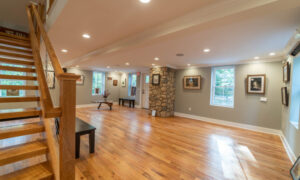
Minimalism in interior design does not necessarily have to be cold and boring. Given the minimalism concept of “less is more”, the new way to think about it is just not as a plain white box but a concept that showcases exceptional functional design along with artistic beauty in a simplified environment to live.
The advantages of embracing a simple and monochromatic style are plenty and going for minimalism will most likely reduce the clutter. Consequently, creating a clear and simplified interior at home will reduce the levels of stress.
However, what you should bear in mind is that incorporating a minimalistic design style into your home interior is not as easy as you may think and there are some prerequisites that you may have to take before you start your home renovation.
Minimalist design features simplicity and elegance by eliminating every unnecessary element to include only the essentials. This streamlined, clean, and simple architecture is not only pleasing to the eyes but also helps you to incorporate functionality within your compact and simple house.
Here, we will describe some of the most important do’s and don’ts of incorporating a minimalist yet cool and trendy design into your home. Through these tips and tricks, you can be sure of creating a minimalist theme based on your requirements, preferences, and specifications.
DECLUTTER YOUR HOME
The most important element of a minimalist interior style is to declutter your home. If you find your home in a constant mess where there are piles of unnecessary documents, shoes, and clothes on the floor, empty cups and glasses as well as random objects on the table or any other flat surface – then it’s high time you clear everything up.
The first and most important step to embracing the minimalistic design look and feel is to find each object its specific spot. To be even more efficient in making sure your surfaces stay clear, you should follow the rule of “one in, one out”.
The main idea of minimalism as an interior design style is to provide a clear and practical space where the homeowners keep only the objects they need and use daily. With this in mind, all nonessentials and unused products that are collecting dust should be eliminated simply because they’re cluttering the so valuable room in your home. The “one in, one out” philosophy allows you to preserve the balance, especially when you’re replacing similar items.
Consider the following project at Bukit Batok West, Singapore. The theme is kept simple and there is no cluttering of elements anywhere; everything essential is placed at the right place which does not cramp the area.
DON’T USE COMPLEX COLOR SCHEMES
Whenever you are designing or renovating your home, you may be inclined to use your favourite colours in all of the elements of a room. However, if you continue with that and try to count the number of colours of all the elements of the room, be it the walls, sofa fabric, cushions, decorative items, furniture, curtains, etc.; you will notice that it will amount to a huge array of colours which will create a visual imbalance and too much to absorb.
Keep the colour scheme simple; choose two to three colours and try to use their different hues for all the elements. A little pop of colour may be added to break the neutrals, otherwise, try to keep the colour scheme simple.
Typically, the best way to keep everything neutral is to follow the 60/30/10 rule. In other words, you choose a dominant base for each room, another to act as a secondary colour and a third that’ll add the accents.
Of course, choosing the base colour is the most difficult part. Nevertheless, there are some quite successful colour combinations for a neat-looking minimalistic design. For example, you can go for a biscuit, greige or even an ecru-inspired tone.
They provide a clean and calming look. Contrary to popular belief, minimalism isn’t plain and bland. Just make sure you allow enough natural light into your rooms to make your home look warmer and cosier.
Consider the following living area of a home at Bedok Reservoir, Singapore which is set beautifully in a minimalistic theme with white as the main colour and pastel blue as the secondary one. A few coloured elements on the shelf add just the right amount of pop to brighten up space.
Beautiful Minimalist Atmosphere at Waterfront Wave, Bedok Reservoir, Singapore
FOCUS ON FUNCTIONALITY
One of the main elements of a minimalist style is functionality; add all the elements that are absolutely necessary and eliminate the unessential ones. This way, automatically you will clear up the space to create a neat, clean, and tidy environment. However, this does not mean that you should not add any decorative items or wall art to bring an artistic touch to the design. In fact, a few decorative items will help to make the white and boring minimalist design more creative and eye-catching.
This is what is showcased in the following image of a room at Punggol Central, Singapore. You can see how the white theme of the functional interior design is contrasted with cool wall hangings and colourful flowers.
MAKE SPACE FOR EMPTY SPACES AND FOCAL POINTS
One of the most important features of a minimalist design is empty spaces. This works very well for HDB interior designs. An empty space helps to define objects and how they interact with the background and other elements. It also helps to define a focal point in each room which you can arrange accordingly. Through this visual balance, the room appears spacious without any unwanted distraction. An example of this would be to group similar items together so that the remaining area is left empty. Then after an empty space, you can add a group of elements and again leave some empty space later.
Consider the following living room example at Cantonment Rd, Singapore. Notice on the wall how the shelves are grouped together to leave a lot of white space on the wall. This makes them the focal point and creates a visual balance.
DON’T OVERWHELM WITH DECORATIVE ITEMS
Another important feature of a cool minimalist design is not to over-decorate with décor items. Instead, only use decorative items as accents or define focal points. What this means, for example, is to use one big wall hanging instead of many smaller ones to avoid clutter and distractions. For décor items, choose something which will immediately catch attention and try to make it a focal point by not over-shadowing it with other elements.
Notice in the following condo design at Parc Olympia, Flora Drive, Singapore how the two large paintings add just the right amount to art to the aesthetics in the room and still be the focal point while all the other things are kept simple.
INCORPORATE TEXTURES
As mentioned above, there’s that popular misconception about minimalism and how its neutral tones create a cold and bland feel. Warm color palette combined with stylish knitted throws, beaded pillows or sheepskin rugs. If you think that a minimalist interior design is too boring, adding different textures in a room will add the kind of excitement that you require. This can be in the form of wooden elements, upholstered furniture, plush fabrics, textured wallpaper, etc. All the textures combined together will add to the textural story of the room without it being overwhelming.
Also, don’t forget the velvet décor. Indeed, these examples may sound quite outlandish, considering we’re talking about the minimalistic style where everything’s expected to be sly and standard-looking.
On the contrary, you shouldn’t shy away from picking unexpected textures, materials, and surfaces. Nevertheless, you should stick to the point and make sure you don’t overdo the whole process. With this being said, you should incorporate these styles only as long as they blend the colour base.
The textures in similar tones will serve as your secret weapon that’ll add to the functional and aesthetic value of your furnishing and room as a whole. After all, what’s better than having a plush rug or a couple of beautiful pillows to match your bed?
As an example, consider the following bedroom at Punggol Central, Singapore. The upholstered bed creates a different texture from the textured wallpaper. The plush curtains add another dimension of texture to the room which has a wooden textured floor. All these textures add some unique balance to the design while still keeping things simple and functional.
Bedroom Design at Punggol Central, Singapore
DON’T KEEP THE AREA DARK
Another important feature of the minimalist theme is to allow lots of natural light to flow in. a brightly lit room appears spacious, neat, and crisp which are the hallmarks of minimalism. To achieve this effect, you can incorporate large-sized windows in the rooms. A room that is not appropriately lit by natural light will appear gloomy and cramped. The perfect option would be to keep the windows unadorned or to use very thin or sheer curtains so that maximum light can flow in the room.
This same effect is achieved in the following image of a living room at Punggol Central, Singapore that is designed by us. Notice the sheer white curtains that allow natural sunlight to flow in and illuminate the room to give a bright and uplifting effect.
USE SIMPLE OBJECTS AND WALL ART
Since a minimalist design is all about simplicity, it is only logical to use simple objects and wall art. Do not spend too much on luxurious decor items and complex wall art as it will go against the simplicity of the minimalist theme. Try to keep things simple without adding too complex or extra elements.
The following image is an example of using simple objects and wall art to create a very cool and elegant interior design for condominium homes.
ADD PATTERNED ELEMENTS
One more important feature of a minimalist design is to add patterned elements to the design. These patterns could be in the form of a rug, sofa cushions, curtains, or wall art. When everything else is simple and solid-coloured, some kind of pattern will never go wrong. In fact, it will help to bring everything together in beautiful harmony and elegance.
Geometric patterns are especially a significant feature of minimalist designs. This is depicted in the following living room image of a condo at St. Patrick Rd, Singapore. Notice how the walls are neutral and the sofa is solid coloured. The geometric pattern rug and a patterned cushion help to balance everything and creates an element of beauty and elegance.
MINIMALIST STYLE FURNITURE OR HOW TO CHOOSE QUALITY OVER QUANTITY
Creating a practical yet stylish minimalist interior may look as easy as pie. In actuality, it requires a great amount of thoughtful and careful consideration of the assortment of furnishings you wish to incorporate in each room.
This is surely a tough challenge but it’s still fairly achievable if you consider each piece carefully before it enters your home. In the end, you should create a spacy and comfy minimalistic interior.
To ensure that you get the most out of your space, investing in quality furniture is key. Moreover, you can bet on the classics if you want to spend your money on something that will stand the test of time.
Avoid impulsive purchases of trendy items that’ll quickly date. Essentially, you’ll spend much more time on choosing the pieces that best suit your minimalist room décor but you’ll be a lot more content with your choices in the long run.
MINIMALISM IS STORING YOUR ITEMS PROPERLY
Last but not least, all steps mentioned above would mean nothing if you don’t find a way to keep things as they are. In other words, investing in stylish and efficient storage will prevent any mess in your home while adding to its looks.
Of course, storing your items properly doesn’t necessarily mean that you have to give up on your collector’s mindset. However, bear in mind that you can’t consider your home functional until you have plenty and enough storage.
In a true minimalistic spirit, going for hidden storage will be perfectly in line with your home’s new interior design style. For instance, you can install additional drawers behind your doors or buy a storage bed where you can put your clothes.
Nowadays, foldable beds are increasingly popular and getting one can amplify the minimalistic look of your bedroom. One thing is sure, you shouldn’t be afraid to add any pieces of organizational furniture where needed. Just make sure everything’s properly stored.
FINAL THOUGHTS
To conclude, making things look as simple and clear as possible is certainly the essence of minimalism. But this is only on the outer side. Achieving a minimalist interior design isn’t an easy task and there are some key steps for successful minimalist home décor.
Of course, there will always be critics but minimalism can be quite practical for day-to-day use if you manage to execute it the right way. The aesthetic appeal of pure simplicity, clean lines, and warm textures and tones will no doubt spruce up your home with a sly and calming minimalistic atmosphere. Who doesn’t love a neat and clean minimalist space?
This article first appeared on https://www.spacefactor.com.sg/dos-and-donts-cool-minimalist-interior-design/. Space Factor is one of the reliable companies that’ll make your renovation a truly enjoyable and refreshing experience. Based in Singapore, we offer expert design advice and services for everyone willing to try something new with their home.






